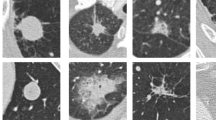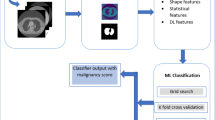Abstract
This study aimed to assist doctors in detecting early-stage lung cancer. To achieve this, a hierarchical system that can detect nodules in the lungs using computed tomography (CT) images was developed. In the initial phase, a preexisting model (YOLOv5s) was used to detect lung nodules. A 0.3 confidence threshold was established for identifying nodules in this phase to enhance the model's sensitivity. The primary objective of the hierarchical model was to locate and categorize all lung nodules while minimizing the false-negative rate. Following the analysis of the results from the first phase, a novel 3D convolutional neural network (CNN) classifier was developed to examine and categorize the potential nodules detected by the YOLOv5s model. The objective was to create a detection framework characterized by an extremely low false positive rate and high accuracy. The Lung Nodule Analysis 2016 (LUNA 16) dataset was used to evaluate the effectiveness of this framework. This dataset comprises 888 CT scans that include the positions of 1186 nodules and 400,000 non-nodular regions in the lungs. The YOLOv5s technique yielded numerous incorrect detections owing to its low confidence level. Nevertheless, the addition of a 3D classification system significantly enhanced the precision of nodule identification. By integrating the outcomes of the YOLOv5s approach using a 30% confidence limit and the 3D CNN classification model, the overall system achieved 98.4% nodule detection accuracy and an area under the curve of 98.9%. Despite producing some false negatives and false positives, the suggested method for identifying lung nodules from CT scans is promising as a valuable aid in decision-making for nodule detection.









Similar content being viewed by others
References
Wood DE, Kazerooni EA, Aberle D, Berman A, Brown LM, Eapen GA, et al. NCCN Guidelines® Insights: Lung Cancer Screening, Version 1.2022: Featured Updates to the NCCN Guidelines. J Nat Compreh Cancer Net. 2022. https://doi.org/10.6004/jnccn.2022.0036.
Cruickshank A, Stieler G, Ameer F. Evaluation of the solitary pulmonary nodule. Intern Med J. 2019. https://doi.org/10.1111/imj.14219.
Philip B, Jain A, Wojtowicz M, Khan I, Voller C, Patel RS, et al. Current investigative modalities for detecting and staging lung cancers: a comprehensive summary. Indian journal of thoracic and cardiovascular surgery. 2023. https://doi.org/10.1007/s12055-022-01430-2.
MacRedmond R, McVey G, Lee M, Costello R, Kenny D, Foley C, et al. Screening for lung cancer using low dose CT scanning: results of 2 year follow up. Thorax. 2006. https://doi.org/10.1136/thx.2004.037580.
Pehrson LM, Nielsen MB, Ammitzbøl LC. Automatic pulmonary nodule detection applying deep learning or machine learning algorithms to the LIDC-IDRI database: a systematic review. Diagnostics. 2019. https://doi.org/10.3390/diagnostics9010029.
Xiao Z, Liu B, Geng L, Zhang F, Liu Y. Segmentation of lung nodules using improved 3D-UNet neural network. Symmetry. 2020. https://doi.org/10.3390/sym12111787.
Nguyen T, Hua B-S, Le N. 3d-ucaps: 3d capsules unet for volumetric image segmentation. Medical Image Computing and Computer Assisted Intervention–MICCAI 2021: 24th International Conference, Strasbourg, France, September 27–October 1, 2021, Proceedings, Part I 24: Springer. 2021; https://doi.org/10.1007/978-3-030-87193-2_52.
Gu Y, Lai Y, Xie P, Wei J, Lu Y. Multi-scale prediction network for lung segmentation. 2019 IEEE 16th International Symposium on Biomedical Imaging (ISBI 2019): IEEE; 2019; https://doi.org/10.1109/ISBI.2019.8759207.
Chon A, Balachandar N, Lu P (2017). Deep convolutional neural networks for lung cancer detection. Standford University https://doi.org/10.14445/22312803/IJCTT-V67I11P104.
Tran GS, Nghiem TP, Nguyen VT, Luong CM, Burie J-C. Improving accuracy of lung nodule classification using deep learning with focal loss. Journal of healthcare engineering. 2019. https://doi.org/10.1155/2019/5156416.
Alakwaa W, Nassef M, Badr A (2017). Lung cancer detection and classification with 3D convolutional neural network (3D-CNN). Int J Adv Comp Sci Appl https://doi.org/10.14569/IJACSA.2017.080853.
Zhang G, Yang Z, Gong L, Jiang S, Wang L. Classification of benign and malignant lung nodules from CT images based on hybrid features. Phys Med Biol. 2019. https://doi.org/10.1088/1361-6560/ab2544.
Kopelowitz E, Engelhard G (2019). Lung nodules detection and segmentation using 3D mask-RCNN. arXiv preprint arXiv:190707676. https://doi.org/10.48550/arXiv.1907.07676.
Cai L, Long T, Dai Y, Huang Y. Mask R-CNN-based detection and segmentation for pulmonary nodule 3D visualization diagnosis. IEEE Access. 2020. https://doi.org/10.1109/ACCESS.2020.2976432.
Pereira FR, De Andrade JMC, Escuissato DL, De Oliveira LF. Classifier ensemble based on computed tomography attenuation patterns for computer-aided detection system. IEEE Access. 2021. https://doi.org/10.1109/ACCESS.2021.3109860.
Nguyen CC, Tran GS, Burie J-C, Nghiem TP. Pulmonary nodule detection based on faster R-CNN with adaptive anchor box. IEEE Access. 2021. https://doi.org/10.1109/ACCESS.2021.3128942.
He K, Zhang X, Ren S, Sun J. Deep residual learning for image recognition. Proc IEEE Conf Comput Vis Pattern Recognit. 2016. https://doi.org/10.1109/CVPR.2016.90.
Fan R, Kamata S-i, Chen Y. Pulmonary nodule detection using improved faster R-CNN and 3D Resnet. Thirteenth International Conference on Digital Image Processing (ICDIP 2021): SPIE. 2021; https://doi.org/10.1117/12.2599884.
Kim J-a, Sung J-Y, Park S-h. Comparison of Faster-RCNN, YOLO, and SSD for real-time vehicle type recognition. 2020 IEEE international conference on consumer electronics-Asia (ICCE-Asia): IEEE. 2020; https://doi.org/10.3390/s20174938.
Agnes SA, Anitha J, Solomon AA. Two-stage lung nodule detection framework using enhanced UNet and convolutional LSTM networks in CT images. Comput Biol Med. 2022. https://doi.org/10.1016/j.compbiomed.2022.106059.
Redmon J, Divvala S, Girshick R, Farhadi A. You only look once: Unified, real-time object detection. Proc IEEE Conf Comput Vis Pattern Recognit. 2016. https://doi.org/10.1109/CVPR.2016.91.
Al-Masni MA, Al-Antari MA, Park J-M, Gi G, Kim T-Y, Rivera P, et al. Simultaneous detection and classification of breast masses in digital mammograms via a deep learning YOLO-based CAD system. Comput Methods Programs Biomed. 2018. https://doi.org/10.1016/j.cmpb.2018.01.017.
Baccouche A, Garcia-Zapirain B, Olea CC, Elmaghraby AS (2021). Breast Lesions Detection and Classification via YOLO-Based Fusion Models. Comp Mater Cont https://doi.org/10.32604/cmc.2021.018461.
Nie Y, Sommella P, O’Nils M, Liguori C, Lundgren J. Automatic detection of melanoma with yolo deep convolutional neural networks. 2019 E-Health and Bioengineering Conference (EHB): IEEE. 2019; https://doi.org/10.1109/EHB47216.2019.8970033.
George J, Skaria S, Varun V (2018). Using YOLO based deep learning network for real time detection and localization of lung nodules from low dose CT scans. Medical Imaging 2018: Computer-Aided Diagnosis: SPIE. https://doi.org/10.1117/12.2293699.
Huang Y-S, Chou P-R, Chen H-M, Chang Y-C, Chang R-F. One-stage pulmonary nodule detection using 3-D DCNN with feature fusion and attention mechanism in CT image. Comput Methods Programs Biomed. 2022. https://doi.org/10.1016/j.cmpb.2022.106786.
Srivastava S, Divekar AV, Anilkumar C, Naik I, Kulkarni V, Pattabiraman V. Comparative analysis of deep learning image detection algorithms. Journal of Big data. 2021. https://doi.org/10.1186/s40537-021-00434-w.
Ahmed KR. Smart pothole detection using deep learning based on dilated convolution. Sensors. 2021. https://doi.org/10.3390/s21248406.
Mahendrakar T, Ekblad A, Fischer N, White R, Wilde M, Kish B, et al. Performance study of yolov5 and faster r-cnn for autonomous navigation around non-cooperative targets. 2022 IEEE Aerospace Conference (AERO): IEEE. 2022; https://doi.org/10.1109/AERO53065.2022.9843537.
Armato S. rd, McLennan G, Bidaut L, McNitt-Gray MF, Meyer CR, Reeves AP, et al. (2011). The lung image database consortium (LIDC) and image database resource initiative (IDRI): A completed reference database of lung nodules on CT scans. Med Phys https://doi.org/10.1118/1.3528204.
Lin T-Y, Maire M, Belongie S, Hays J, Perona P, Ramanan D, et al. Microsoft coco: Common objects in context. Computer Vision–ECCV 2014: 13th European Conference, Zurich, Switzerland, September 6–12, 2014, Proceedings, Part V 13: Springer. 2014; https://doi.org/10.1007/978-3-319-10602-1_48.
Li Z, Tian X, Liu X, Liu Y, Shi X. A two-stage industrial defect detection framework based on improved-yolov5 and optimized-inception-resnetv2 models. Appl Sci. 2022. https://doi.org/10.3390/app12020834.
Kim D, Park S, Kang D, Paik J. Improved center and scale prediction-based pedestrian detection using convolutional block. 2019 IEEE 9th International Conference on Consumer Electronics (ICCE-Berlin): IEEE. 2019; https://doi.org/10.1109/ICCE-Berlin47944.2019.8966154.
Wang W, Xie E, Song X, Zang Y, Wang W, Lu T, et al. Efficient and accurate arbitrary-shaped text detection with pixel aggregation network. Proceedings of the IEEE/CVF international conference on computer vision. 2019; https://doi.org/10.48550/arXiv.1908.05900.
Funding
We would like to state that no external funding or financial support was received for this research. The study was conducted independently without any monetary contributions from any organization or entity.
Author information
Authors and Affiliations
Corresponding author
Ethics declarations
Conflict of interest
The authors declare no financial or non-financial conflicts of interest.
Ethical approval
All procedures performed were in accordance with the ethical standards of the internal institution’s ethical committee and with the 1964 Helsinki Declaration and its later amendments or comparable ethical standards.
Additional information
Publisher's Note
Springer Nature remains neutral with regard to jurisdictional claims in published maps and institutional affiliations.
About this article
Cite this article
Ahmadyar, Y., Kamali-Asl, A., Arabi, H. et al. Hierarchical approach for pulmonary-nodule identification from CT images using YOLO model and a 3D neural network classifier. Radiol Phys Technol 17, 124–134 (2024). https://doi.org/10.1007/s12194-023-00756-9
Received:
Revised:
Accepted:
Published:
Issue Date:
DOI: https://doi.org/10.1007/s12194-023-00756-9




